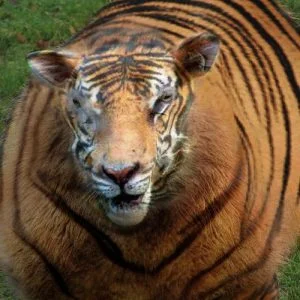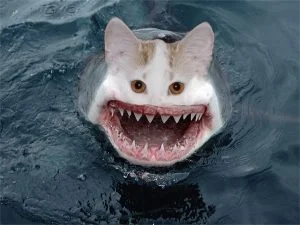Fake or Real? Teaching Kids to Question
What Did I Just See?
As the saying goes, "seeing is believing", but in today's world, the old saying could very well cease to be true. Even for the most savvy, it is increasingly easy to fall down the rabbit hole of believing fake information posted on the internet. In fact, I personally fell victim to this recently. It was just for a few minutes, nevertheless, for that short time I believed an image to be to be real because it lookedreal. Upon closer inspection, I saw the extremely good and perhaps too perfect Photoshop work that was done, which allowed me to finally notice the flaws in the image I was staring at. I don't consider myself an expert or a trained eye, but I do know some features of image editing which help me to identify when an image has been enhanced and/or changed. To anyone else, the photo would most likely look believable.
So, what made me look closer? Why didn't I just believe it? The main answer: I was so surprised by the image that I wanted to know where the image was from, so I checked the source. Low and behold, the image actually found its way into cyberspace through a gossip site. Allow me to defend myself a little here, I don't read gossip sites! I was doing an image search when I came across this very realistic picture ;) This forced me to ask how many of my students would have questioned the source of that image? I am willing to bet that most of them wouldn't have bothered, and many would have walked away with the understanding that it was a real image. This reminded me of something I read in A More Beautiful Question by Warren Berger. Berger (2014) points out that young children, particularly four-year-olds, are at the peak of their natural questioning abilities. Preschoolers could then be in their prime for learning how to question and deliberate on information they receive through various media sources.
Information today is so easily altered, edited, and disseminated that we can no longer just rely on the old saying, "seeing is believing". In fact, the skill of critical thought and questioning becomes imperative to being an informed citizen and member of society. For this reason, I found myself designing lessons around questioning information as a final project for one of my graduate school classes (The class was on Technology and Democracy). This blog post will outline the series of four lessons from this project which are aimed at Kindergarten aged students but can be adapted for many age groups.
ACRL Framework for Information Literacy
When I proposed this project to my professor, he sent me the ACRL Framework for Information Literacy as a possible resource. Although the framework is aimed at high school and university level students, I personally found that many of the goals within the framework were still applicable to or adaptable for elementary and early childhood students, it was just a matter of adjusting the type of content students were assessing. So, I used the goals from the framework as my key goals and objectives within each lesson.
Lesson 1: Information in Books
Dewey (1916) points out that when introducing new ideas, we should try to connect these ideas to things that students are currently familiar with so that they can be placed in a meaningful context. For this reason, the first lesson aims to introduce the questioning and deliberation process by discussing information in books found in a Kindergarten classroom. I also wanted to introduce and develop the habit of questioning information, even if the person who handed you that piece of information is someone you trust, like your teacher.
For this lesson I searched for both fiction and non-fiction books. I also tried to find books that perhaps were considered fiction but contained real information, as well as non-fiction books that were illustrated rather than containing photographs. I hoped this would encourage deliberation around which elements of the book that might contain real information and which might be fake or made up. It also helped students begin to procss their own understandings of "fake" and "real". I got two copies of each book so that students could be paired up for discussion about the same text but still be given time for independent exploration. Here are some of the titles that I used:
National Geographic Little Kids Magazines
Some of my choices were limited because I couldn't find a second copy of particular books, but there are so many books that would work for this activity, just a raid your school or classroom library!
We did a brief Think, Pair, Share on the carpet where students explored their books individually looking for information they thought was real or fake (or perhaps something that they were unsure of). Then I had them pair up with their same-book partner and discuss what they each found. Sentence stems were given to help them:
"I think this is real/fake because..."
"I am not sure about this because..."
"I agree/disagree with you because..."
I asked a few groups to share what they discovered with the whole class, and we had a brief whole group discussion around those few examples. The groups then went off with their partners to record their thinking into Seesaw. A number of apps could be used for this as long as you can take a photo and record what they noticed. Here are some examples of what students recorded.
If there is time, it is also fun to sort books into a Venn diagram or just sort the books physically on the carpet as a class. This type of exercise can help students deliberate where they think a book might belong. In many cases, students ended up moving books into the middle of the Venn diagram because after discussion they realized that many books contain both real and fake information, and it is up to the reader to discern which parts are real and which are fake. Here is an example of a Venn diagram I made with one class using Doodlecast Pro. We didn't get very far because we ran out of time.
Lesson 2&3: Analyzing Videos
This is a category of media that I spent more time on because I am very aware of the fact that many of my students (yes, even in kindergarten) are watching YouTube videos. I wanted students to develop some critical thinking skills when watching videos online, so the first part of this section involves the class watching one video together, the second allows students to search on their own for a video they would like to analyze.
For the first lesson, I chose the video Sidewalk Cops 7: Texting Superman! I decided this video would challenge students to consider both real and fake elements, as well as ask questions about information they may be unsure about. We watched the video twice. The first time I had the students watch it without any prompts apart from, "What information do you think is fake or real in this video?" The second time we watched it I gave my students a See, Think, Wonder sheet to sketch notes on with a partner. I showed students how to make quick sketch/visual notes that can be easier than writing words when we are trying to take quick notes. As usual we had students document their work into Seesaw so they could explain their thinking.
Here is the video:
During the second lesson, I allowed students (working in partners again) to search YouTube Kids for a video they wanted to watch. As a class I had students share videos that they had watched before on YouTube and I listed them down, this way, if students had trouble deciding what to search for, they could draw ideas from the list. I then showed students how to use the search tool in the app and use the microphone to say their keyword/s. This way, students did not have to worry about spelling. Students were allowed to watch the chosen video as many times as they wanted, but were not allowed to shift from one video to the next. They were also taught how to pause videos to stop and take sketch notes. For this lesson I gave them a similar sheet to fill out as last time and documented their thinking on Seesaw.
These sheets are pretty straightforward to create but if you would like to use mine here they are for downloading! :)
[wpdm_package id='1418']
Lesson 4: Looking Closely at Photographs
The final lesson in this series looks at photographs. I got the kids excited by telling them that this time the task was more challenging! There is no sound or movement in photographs, so it is harder to tell whether or not parts of an image are real or fake. It would take close looking and investigating! We first looked at two photos together and discussed whether or not they were real:
All of my students felt that these two animals had to be fake because they had never seen such animals before. They supported their ideas further with statements such as, "Cats don't like water." and "Sharks don't have ears!"
I then showed them how to search a site called Photos for Class on their iPads. I asked partnerships to choose an animal and search for:
- One photo that they thought was a real photo of that animal
- One photo they thought was fake or had fake elements in it of the same animal
- One photo that they weren't sure about
This was also an exercise in searching the internet for information and understanding how to put keywords together to find what you need. Students soon learned that they needed to type in "fake (name of animal)" in order to try to find fake images. Teachers did need to help certain groups (it really depended on the animal the students chose), sometimes we typed in "photoshopped (name of animal)" and got better results.
Students learned how to save images to the camera roll and then combined them into Pic Collage Kids. They shared these collages and explained them on Seesaw.
Here are a few examples:
We probably could have continued these lessons digging deeper and making comparisons between media types too. I would love to hear about other ways you are teaching students to be more critical about information they receive through various types of media, especially in early childhood! :)


